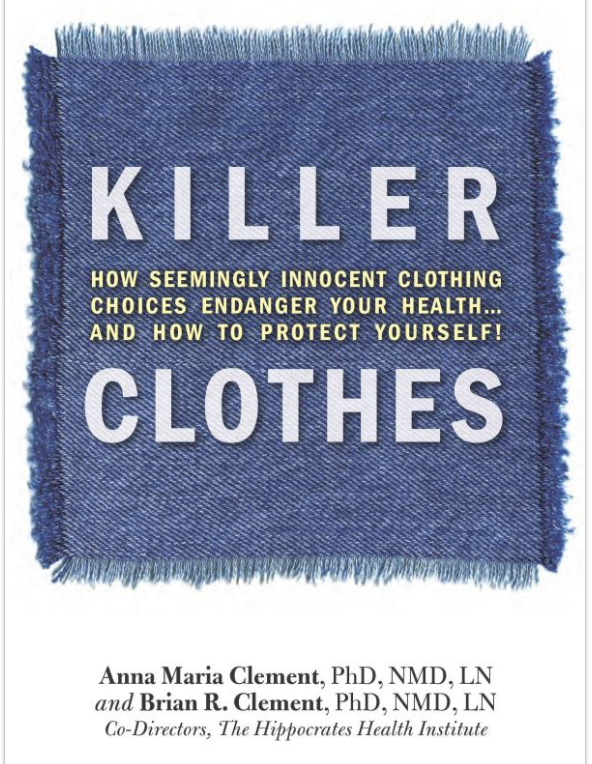“Killer Clothes”: 4 Insane (But True) Things About Synthetic Clothing

Revisting “Killer Clothes” – a book on sustainable fashion, that reveals it all. From pesticides to toxic dyes, it unpacks the underlying dangers of seemingly ‘ethical’, synthetic clothing.
Many sustainable brands advertise synthetic clothing as eco-friendly. Using toxic garment dyes and finishes, they claim this to be a greener option. However, are man-made fibres really ethical? “Killer Clothes” takes a deep look into the dangers of synthetic textiles, which have been hidden from the public eye
According to McKinsey & Co, 70% of consumers view the use of sustainable materials as an important purchasing factor. Yet, eco-conscious clothing labels rarely speak to them. When shopping, consumers struggle with avoiding certain fabrics and making the right choices. When it comes to ethical shopping, 50% of consumers the brands’ environmental credentials confusing or deceitful.
As always, the consumer is right. Most ‘conscious’ collections still incorporate hazardous, synthetic textiles that are only “partially recycled.” Their eco-labels do nothing but distract shoppers from all the health risks lurking in their wardrobes. With the rise of greenwashing, trusting sustainable brands blindly is not enough.
After all, how can clothes be eco-friendly if they’re made out of synthetic materials? Numerous medical studies show that textiles, which the fashion industry considers safe, can harm your health and the environment. That’s why it’s more important than ever to take your health into your own hands.
Here are 4 insane things about synthetic apparel that you should know, according to the book:
Synthetic clothing spreads harmful nanoparticles
Did you know that on average, clothes lose 10 percent of their weight by the end of their lifecycle? When it comes to natural fabrics, their abrasion causes no harm to your health. Synthetics, on the other hand, emit hazardous nanoparticles both in the environment and your body. According to Particle Fibre Toxicology, clothes release 322 mg/kg of nanoparticles due to everyday human wear. Found in anti-stain and water-resistant fabrics, PFCs (per-fluorinated chemicals) disrupt hormones. Phalates, which appear in print designs, even affect reproductive development. Penetrating the skin, these nanoparticles swim through the bloodstream and accumulate in our brain, cells, and nerves.
For this reason, “Killer Clothes” advises us to avoid synthetic clothes with flame-resistant, wrinkle-free, anti-fungal, or antibacterial properties. These clothes contain garment finishes with toxic chemicals that pose significant risks to our health.
If your clothing is described as flame retardant, stain resistant, permanent press, antistatic or non-shrink, you can be pretty sure that synthetic chemicals were either directly applied to the fabric or bonded into the fabric, and the residue can induce allergic reactions in some people.
Dyes in synthetic fibers may never leave your body
During production and manufacturing, synthetic clothing gets sprayed with garment finishes, solvents, acids, and biocides. Nike estimates that more than 4,000 chemicals circulate in its supply chain alone. These so-called ‘innovative’ compounds and dyes are hard to get rid of – they linger in fabrics until the very end of the garment lifecycle.“Killer Clothes” introduces a vast array of toxins that bind dye colors with fabrics. Found in 100% polyester and acetate clothes, dispersed blue 1 dye leads to malignant tumor formation in experimental animals. Other hazmats in synthetic fabrics, such as formaldehyde and dioxane, are known hormone disrupters and carcinogens (cancer-causing agents).
Many of these chemicals were designed to be virtually immortal and don’t break down easily. Once in human body fat, they accumulate over a lifetime with a variety of potential effects on health.
Known as bioaccumulation, the toxins can collect in body tissues and cause endocrine system disorders in lab animals. Slowly but surely, synthetic textiles lead to a tipping point for a lot of autoimmune disorders. That’s why consumers should beware of chemical contamination through clothes, even in small quantities.
Man-made textiles trigger skin problems
As brands spray their garments with carcinogens, our skin flora falls victim to toxic substances. Research shows that prolonged and repetitive exposure to silver nanoparticles damage the protective function of the skin. This is especially true if one wears tight clothes that trap heat and trigger acne over time. According to Killer Clothes, the sudden rise in skin conditions can be attributed to synthetic clothes. From the 1960s to the 2000s, the rates of contact dermatitis rose from 3 to 20 per cent, affecting both children and adults. This occurred over the exact time when man-made fibres were first introduced in industrial countries.
Skin rashes, nausea, fatigue burning, itching, headaches, and difficulty breathing – are just a few of the symptoms associated with chemical clothing sensitivity.
See it for yourself – on a humid day, do synthetic clothes feel more breathable on your skin, as compared to natural fibres?
Synthetic clothing exacerbates the global health crisis
Putting immediate health concerns aside, let’s look at the bigger picture. The chemicals hidden in man-made fabrics not only harm consumers but also garment workers overseas. Those working in manufacturing and textile mills get ingest hazardous chemicals like solvents, flame retardants, and fixatives on a regular basis.
Every 30 seconds, one worker dies from exposure to toxic agents, pesticides, and radiation somewhere in the world.
Despite this, most brands, including ‘ethical’ ones, refuse to part ways with synthetic fabrics.
It [shouldn’t be] a surprise that most manufacturers refuse to accept any real responsibility for the effect their chemical clothing is having on human health.
In the absence of corporate responsibility, regulatory bodies remain silent on the matter. Although certain chemicals like amine-formed dyes are banned in the EU, they’re still legal in the US. Hence, at the end of the day, it’s up to consumers to research and protect themselves from chemical exposure.
An alarming 65 separate clothing brands in China were found to contain toxic dyes that are known cancer-causing agents, or they failed to meet other basic quality standards, according to a 2010 investigation by Beijing’s Bureau of Industry and Commerce.
Considering this, “Killer Clothes” recommends that we track the origins and manufacturing of our garments. Consumer awareness, in tandem with the abstinence from synthetic fabrics, can help us counter the current global health crisis.
FEATURE PHOTO: Photo by Iwaria/Pexel

footnote from article source:
At Impakter, we understand the detriments of synthetic fibers, which is why we feature brands like Amaella and Albero that use natural, organic fabrics in their manufacturing process.
Editor’s Note: The opinions expressed here by Impakter.com contributors are their own, not those of Impakter.com.









